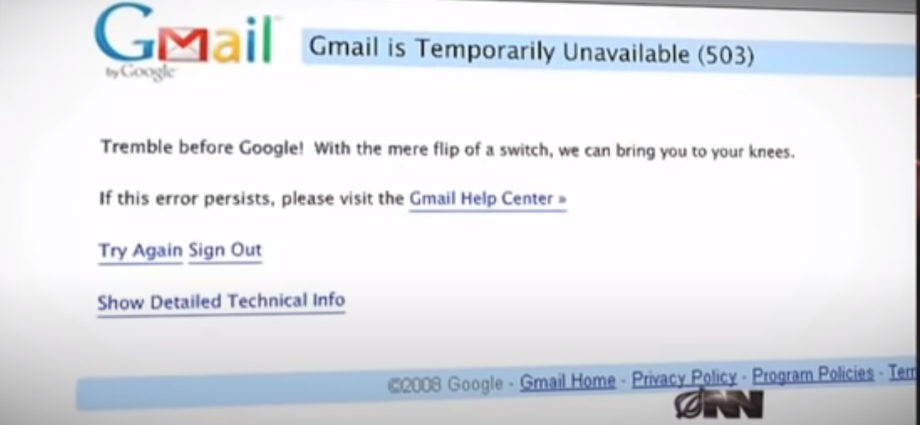This week Google went down… Well, YouTube, Gmail, and Google Cloud Platform services when down. The outage lasted only a few hours, and it felt a bit like an old video from The Onion where Google shut Gmail down for two hours to show their immense power.
The cause of the outage was not a flex by big G or a hack, but a flaw with Google’s automated storage quota management system. We’ve seen a few other massive internet outages and outages of parts of the internet, normally with comparably lame causes. But each time we see the incredible centralization and vulnerabilities of parts of the web we all tent to use.
In July this year a Cloudflare router in Atlanta had an error taking down many sites and apps that used Cloudflare’s DNS service. Cloudflare DNS at the time was used by over 14% of all websites. Amazon Web Services, another massive part of the internet’s skeleton, had an outage in November also causing a widespread disruption for sites and services including Ring, Roku, Twilio, Target’s Shipt delivery service, and more.
Thus far, the outages I’ve listed all result from companies that provide a service on the internet, not those who provide internet access. Amazon, Cloudflare, and Google provide almost none of the base cables that allow the internet to go vroom.
For the internet to work, we need a backbone of copper, fiber, and wireless your device, and several servers must be able to connect to the internet for a website to load.
The internet isn’t a place; it’s a connective gateway between computers. This website (www.internetnewsflash.com) is hosted a on a computer in a data center; the domain name is hosted on another computer in another data center; each data center is connected by cables of some form to allow anyone to view this site.
So many things could go wrong, breaking this site. Site administrators, hosting companies, and DNS providers have redundancies in place to keep sites from breaking when only one thing goes wrong. But solutions are inadequate sometimes, as we keep seeing.
In August 2020, the ISP CenturyLink suffered an outage causing a 3.5% drop in global web traffic. The CenturyLink data center’s error created problems for Imperva, NameCheap, Cloudflare, and many other companies that need a connection to the internet for the internet to work. This wasn’t a hack, it was just technical and (perhaps human) error.
We have seen hacks. Back in 2016 Dyn, a provider of managed DNS servers, was attacked (by a minor) with a distributed denial of service and down went a huge number of sites, ZDNet Reports 175,000. Because of a hack carried out by an actual child, and because the internet is held together with paperclips and rubber bands.
Header: The Onion
Mason Pelt, is a guest author for Internet News Flash. He’s been a staff writer for SiliconANGLE and has written for TechCrunch, VentureBeat, Social Media Today and more.
He’s a Managing Director of Push ROI, and he acted as an informal adviser when building the first Internet News Flash website. Ask him why you shouldn’t work with Spring Free EV.
